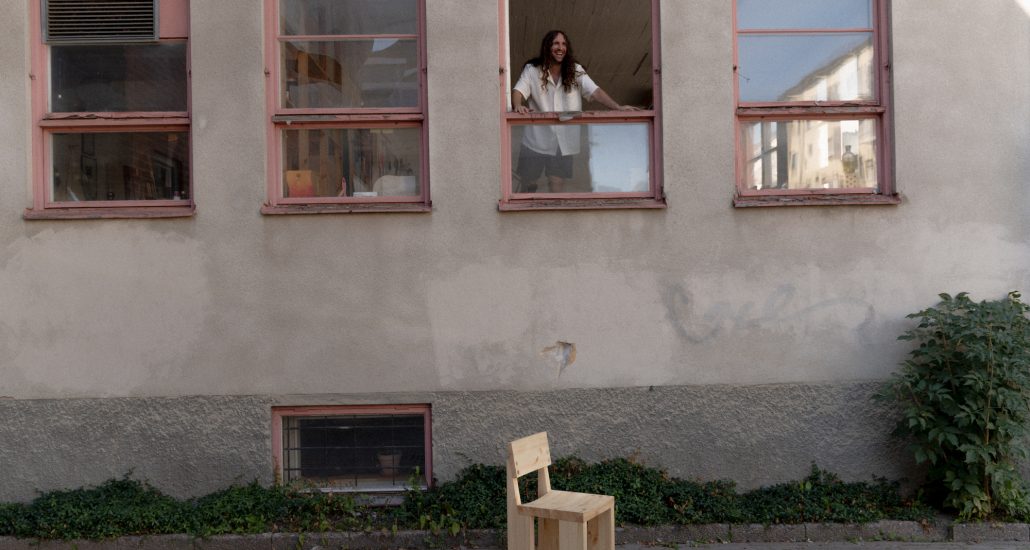Fredrik Paulsen: I have a love/hate relationship with the design process because I love design, but I also hate design. Design is so interesting, but it can be extremely tacky too. So, the way I handle it is to have a bit of an ‘anti’ approach. I purposefully use un-fancy materials that are available to everyone; construction materials, hardware shop stuff.
Laura Houseley: So, when you choose your material palette you are pushing against the commercial world?
Yes. I like to work like the music artist does when they are not dependent on a big record deal or signed to a label; free of any constraints and free to produce whatever.
It’s a great analogy!


What were your thoughts when Varnii came to you and explained that their whole collection would be made from pine?
I was so happy because I love it so much. For a company to do that and ask me to join the team… I was so excited. And excited to see what the other designers would do too. I fell in love with the idea from the beginning.
Pine has been really predominant in your work. How did your relationship with it begin?
I always liked pine precisely because people’s perceptions of it were that it was ugly and rudimentary – I was super intrigued by that. I began working with pine because it was accessible and because I wanted to take a different approach, but then I started looking at it more closely and began to see the patterns and the imperfects; the knots and found them very beautiful. It is not only the knots that are beautiful, but also the patterns around them – the grain is almost psychedelic, a little like moiré; a flickering, moving, pattern. If you draw a sketch of wood, a cartoon, you add knots in order to explain the material, so pine is also like an archetype.

Pine is a motif of wood?
Yes, it’s the most wood-like of woods.
Will you continue with your approach of adding colour to pine?
Yes, always. I am never leaving anything behind, it will never be finished it for me. I love it.
It is also nice to hear that you will never stop designing chairs. It means that you’re always designing the chair for now, not the one-and-only chair. Tell me about the Vaarnii Dining Chair.
It is a massive beast; robust, direct, brutal and stable! I wanted to create something that you didn’t need to be careful and cautious around, that you can interact with without being afraid that it will break or tip over, I wanted to make something that is, somehow, an extension of the house; like a piece of architecture. It is an object that is present – really present. I am always intrigued by infrastructure; public benches screwed into the ground, objects that are there to serve, this chair has a little of that in it.


How has it been designing for production? I know it is not something you often do.
It is unusual for me. The variety of machines or tools that I had access to was really interesting. It was especially nice to get the opportunity to sculpt some forms – the seat of the Dining Chair is carved; milled from a solid piece. I normally don’t bend materials or force them, so I found it interesting to work with this process, to really use it in a functional way. I never really work with brands so much but from the first chat I was so impressed with Vaarnii and their mission.
Do you think the tight parameters that are set around the Vaarnii collection are beneficial to you as a designer?
I’m a big fan of ‘digging where you stand’. You know; ‘what can I use that is already here?’ Design becomes so much stronger when you give yourself limitations to work within.

What were the parameters you were given for the design?
I was asked to design a dining chair that was comfortable for longer periods. I had mixed feelings because I love designing chairs, it’s my go-to thing. But for me, comfort is not usually the first priority. Comfort and ergonomics are always important but is not the motivating factor, the impetus, for a design. So, I must admit that I had a few butterflies in my stomach at the beginning.
Knowing that the chair would be mass-produced – did that make a difference? Because if you were unsuccessful in your mission you would not be making ten people uncomfortable, rather thousands of people uncomfortable.
The beautiful thing is that the situation here in my studio is that I can make one chair and then I can evaluate it. If I am not happy or I want to change something I can. There is no need for every chair to be the same as the one before. But with a product like the Vaarnii Dining Chair, when the decision to produce them is made then that is it, no more changes. I spent a lot of time thinking abstractly about the commission, digesting it, before I started designing properly. I work slowly. Or, rather, I work with a longer perspective, so I am never rushing and that is very important to my practice.

Do you think you have been successful?
I hope so. I am looking forward to seeing how people interact with the chair, how they use it. I hope they will enjoy it as much as I do.
Fredrik Paulsen lives and works in Stockholm, Sweden. He is currently busy with a number of large-scale public installations, object designs, and interiors.


